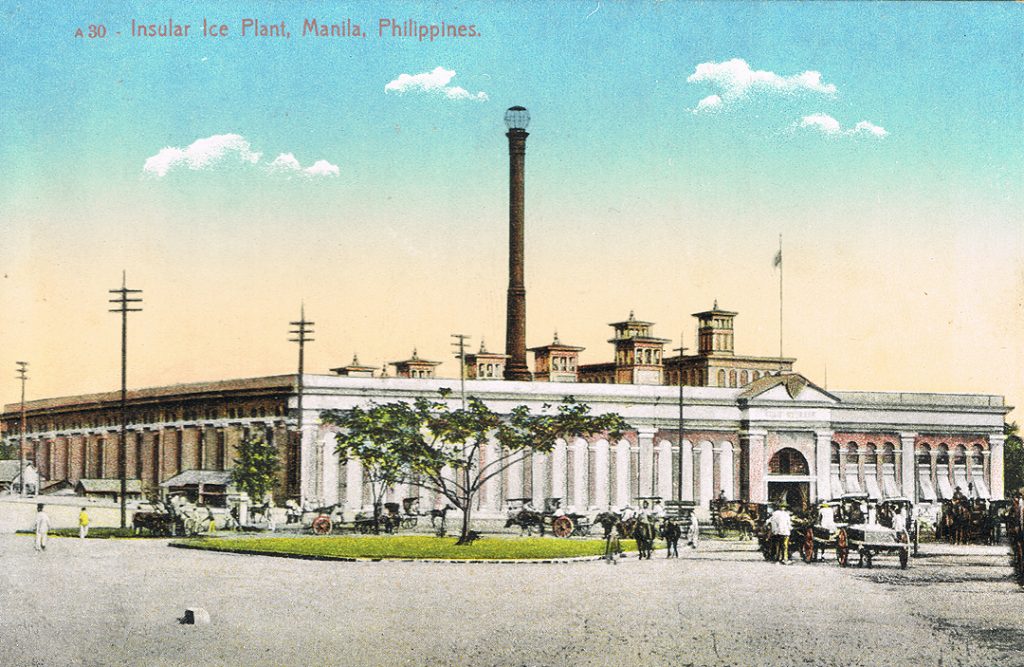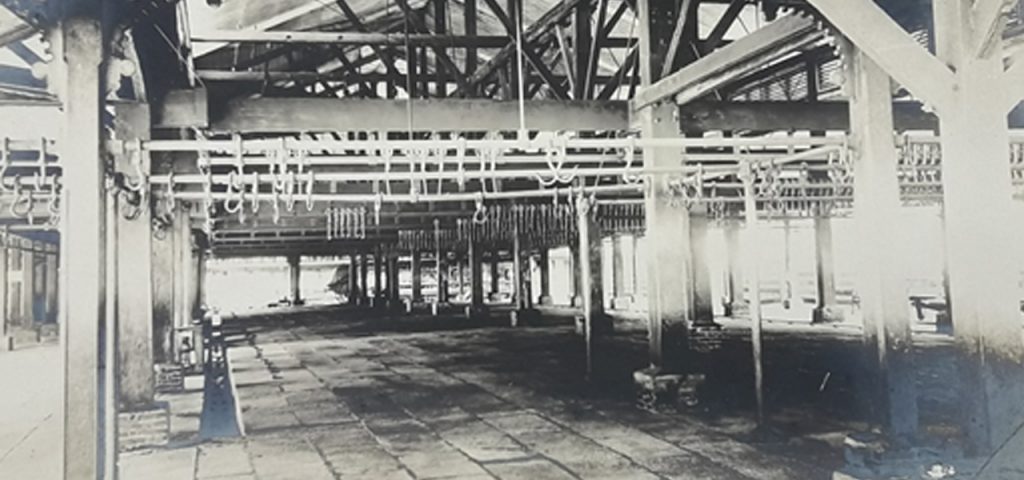
If history is to be correctly observed, a solution for one poses problems for another. The establishment of the Insular Cold Storage and Ice Plant in 1901 was meant to serve the American military’s needs for clean water and fresh meat. Investments on infrastructures to ensure the health of animals and humans can have debilitating effects on the environment.
As the population of Manila grew, from 219,928 residents in 1903 to 285,306 in 1918 (30% increase in the span of 15 years or an average of 2% per annum), the Insular Cold Storage and Ice Plant faced issues concerning capacity, efficiency, and reliability that affected its ability to prevent biodeterioration. While the plant was considered a modern edifice that kept livestock and human health, its exposure to heat, natural occurrences like typhoons and floods, and continued use contributed to its structural deterioration. The plant’s wooden floors, beams, and posts underwent moisture condensation that tended to keep them in a semi-wet or damp condition. In 1910, engineers observed how some of the wooden floors began to fail under varied storage loads. It necessitated them not to use the refrigerated rooms with damaged floors and restrict the weight of loads to lighter ones.[1]
Furthermore, the cold storage’s floorings have sunk to a depth of six inches. Owing to the building’s construction on soft silt along the river, the plant’s machinery was misaligned, which if not addressed, would affect the output and efficiency of the facility.[2] The maintenance, technological improvement, and implementation of strict regulation ensured the quality of frozen meat, and by extension, protection of animal and human health.
These concerns were addressed through the reconstruction of the entire facility which incorporated the use of more durable material and employed new construction methods. The use of reinforced concrete, first experimented in the middle of the nineteenth century and gained popularity by the first half of the twentieth century, was introduced to replace the wooden floorings addressed the problem of moisture. Designed by George B. Asp, the former master-builder of the Bureau of Public Works, the flooring resembled an inverted floor (e.g., the joists appeared uppermost), with a thickness of 6 inches.[3] Reinforced concrete was also used to improve the building’s foundations. The old foundations were of isolated piers formed of granite and concrete into which were inserted the vertical pine posts supporting the floor and meat rails. In order to support heavier meat loads, reinforced concrete was poured on these foundations. This enabled the first and second floors of the cold storage to accommodate a load of 200 pounds per square foot while the third floor at 150 pounds per square foot.[4]
To provide greater efficiency in retaining the coolness of the rooms, the cold storage was provided with modern methods of insulation. Initially, the architects decided to adopt granulated cork, which was a common material used by ice plant operators in the United States. However, granulated cork was also difficult to install in between double floors, walls, and ceilings which inevitably increased the cost of the finished structure. Moreover, when the material was tested to two cold storage rooms, the low temperature was not kept for a longer period of time compared to what had been anticipated. Instead, the granulated cork was replaced with boards of hydraulic compressed cork cemented with asphalt to each other.[5] The changes resulted in lower installation cost but more significant was the thorough and greater retention of temperature. This ensured meat to have a prolonged shelf life and be protected against the growth of microorganisms, all at a lower cost.
The installation of better and more efficient refrigeration equipment required a balance that worked with the maximum efficiency at a limited budget. In its earlier installation, the Insular Cold Storage and Ice Plant consisted of three horizontal duplex ammonia compressors each of 68 tons of refrigeration capacity and producing 40 tons of ice. In the 1920s, the government sought assistance with the Manila Electric Company, a private enterprise engaged in the operation of tramways, telegraphs, and electricity distribution in the city. After two years of exhaustive study, government engineers and company officials came to an agreement of modernizing the refrigeration equipment of the plant. The horizontal duplex ammonia compressors were changed with three Worthington two-stage ammonia compressors that were connected to a Westinghouse 250 horsepower synchronous motors. It implied that the cold storage could produce 147.5 tons of refrigeration from each compressor or 2.17 times the refrigeration capacity from the original, ensuring the distribution of cold temperature for a larger load with lesser energy requirement. Other technological improvements included: the installation of Feather valves that were more lightweight, quiet, and durable, allowing for compressors to work without doing damage to the machine; the installation of three five-inch ball bearing type centrifugal pumps for the circulating the condenser cooling water that deliver 1,110 gallons of water per minute, thereby increasing the pumping efficiency by 80%; and, four Carbondale “Spira-Flo” ammonia condensers where the velocity of the water and heat transmission was greatly improved.[6] By 1930, the cold storage succeeded in producing an average of 75 tons of ice per day, increasing Manila’s ice per capita from 1.8 ton in 1903 to 2.6 tons in 1930.
Their investment in increasing the capacitance of the plant also had to take into consideration how this will be translated into energy consumption. In Western Europe at the turn of the nineteenth century, the main source of energy to power factories and industries was coal, and later, in the twentieth century, electricity. When the Insular Cold Storage and Ice Plant was constructed, its refrigerators ran on coal shipped from Australia and Japan. Its tall chimneys emitted soot that changed the contributed to the growing pollution in Manila, and more specifically, along the banks of the Pasig River. Coal was closely adopted by the other cold storage facilities across the archipelago.
However, the use of Australian and Japanese coals added to the already expensive operational costs of cold storage and ice production. It became more concerning when the demand for cold storage space was decreasing. Being the sole customer of the cold storage facility, the military started to build their own cold storage units within their garrisons across the archipelago. To reduce the costs, Governor-General Luke E. Wright ordered the experimentation of different types of coals in 1905. The coal tests were conducted by the Bureau of Insular Cold Storage and Ice Plant and the Bureau of Science by using coals shipped from Polillo Island off the coast of Tayabas, 103 km east of Manila. After the experiment, the report concluded that Polillo coal “with respect to ashes and smoke it was much superior to either of these [Australian and Japanese coals], the percentage of ash being less than from any coal that has ever been burned in these furnaces.”[7]
While the use of coal-generated the required power to prevent biodeterioration, it also consumed enormous amounts of resources and brought about high levels of waste. According to the coal tests, an average of 18,700 kgs of coal was consumed by the cold storage and ice plant on a daily basis. This entailed at least 107,990 kgs of water or 5 kg of water per 1 kg of coal to ensure that the refrigerators functioned. About 1,000 kgs of ash and refuse were taken from burning that much coal on a daily basis. Worse, the tests recorded the average temperature for escaping gases to 267.5 degrees Celsius which contributed to the humid tropical temperature.[8] The resources consumed and wasted by the cold storage facility brought a significant type of pressure on the urban environment.
The pursuit of controlling biodeterioration was not without costs on human health. The gases and ash emitted by the facility had severe effects on the respiration of residents who resided within its vicinity. In 1913, the municipal council of Iloilo filed a legal case in the Supreme Court claiming the cold storage and ice plant as injurious to the citizens of the city. The council wrote that “the quantity of smoke discharged from the smokestacks of said factory is so great and so dense that it penetrates into the dwelling houses situated near it and causes great annoyance to the residents and prejudice to their health.”[9] It also requested to declare the plant as a nuisance by the high court. However, the Supreme Court ruled that the cold storage cannot be considered as a nuisance as it was essential to the health of the population, and valuable for hospital services, restaurants, hotels, and military. Even though the waste disposed of by the cold storage was injurious, the court ruled that the overall function of the cold storage was to ensure the well-being of the citizens. In this manner, controlling biodeterioration did not guarantee the preservation of all aspects of health nor did it take into account its long term effects on those it purportedly served.
[1] McGregor, “Reconstruction of the Insular Ice Plant,” 23.
[2] “The Government Ice Plant at Manila, P.I.,” Cold Storage and Ice Trade, January 1912, 50.
[3] Ibid.
[4] McGregor, “Reconstruction of the Insular Ice Plant,” 24.
[5] Ibid.
[6] “Manila’s Modernized Ice and Cold Storage Plant,” The Far Eastern Review: Finance, Engineering, Commerce, February 1930, 80.
[7] “Successful Test of Polillo (Philippine Islands) Coal, and Reports of Experts on Same,” The Far Eastern Review: Finance, Engineering, Commerce, January 1906, 223.
[8] Ibid., 223–24.
[9] Trent, The Iloilo Ice and Cold Storage Company vs. The Municipal Council of Iloilo, et al., No. G.R. No. L-7012 (Supreme Court of the Philippines March 26, 1913).

